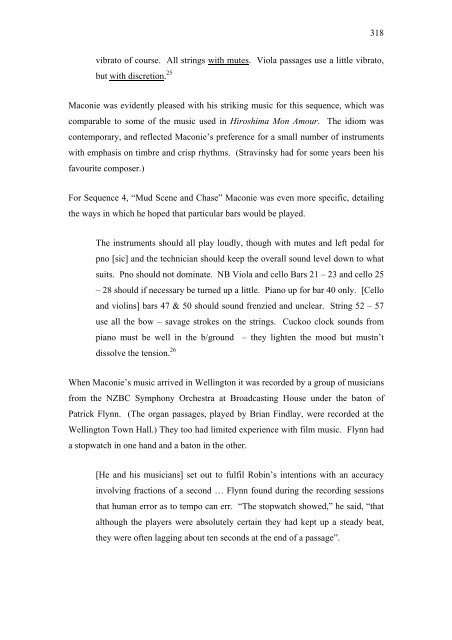Copyright Statement - ResearchSpace@Auckland
Copyright Statement - ResearchSpace@Auckland
Copyright Statement - ResearchSpace@Auckland
Create successful ePaper yourself
Turn your PDF publications into a flip-book with our unique Google optimized e-Paper software.
318<br />
vibrato of course. All strings with mutes. Viola passages use a little vibrato,<br />
but with discretion. 25<br />
Maconie was evidently pleased with his striking music for this sequence, which was<br />
comparable to some of the music used in Hiroshima Mon Amour. The idiom was<br />
contemporary, and reflected Maconie’s preference for a small number of instruments<br />
with emphasis on timbre and crisp rhythms. (Stravinsky had for some years been his<br />
favourite composer.)<br />
For Sequence 4, “Mud Scene and Chase” Maconie was even more specific, detailing<br />
the ways in which he hoped that particular bars would be played.<br />
The instruments should all play loudly, though with mutes and left pedal for<br />
pno [sic] and the technician should keep the overall sound level down to what<br />
suits. Pno should not dominate. NB Viola and cello Bars 21 – 23 and cello 25<br />
– 28 should if necessary be turned up a little. Piano up for bar 40 only. [Cello<br />
and violins] bars 47 & 50 should sound frenzied and unclear. String 52 – 57<br />
use all the bow – savage strokes on the strings. Cuckoo clock sounds from<br />
piano must be well in the b/ground – they lighten the mood but mustn’t<br />
dissolve the tension. 26<br />
When Maconie’s music arrived in Wellington it was recorded by a group of musicians<br />
from the NZBC Symphony Orchestra at Broadcasting House under the baton of<br />
Patrick Flynn. (The organ passages, played by Brian Findlay, were recorded at the<br />
Wellington Town Hall.) They too had limited experience with film music. Flynn had<br />
a stopwatch in one hand and a baton in the other.<br />
[He and his musicians] set out to fulfil Robin’s intentions with an accuracy<br />
involving fractions of a second … Flynn found during the recording sessions<br />
that human error as to tempo can err. “The stopwatch showed,” he said, “that<br />
although the players were absolutely certain they had kept up a steady beat,<br />
they were often lagging about ten seconds at the end of a passage”.















